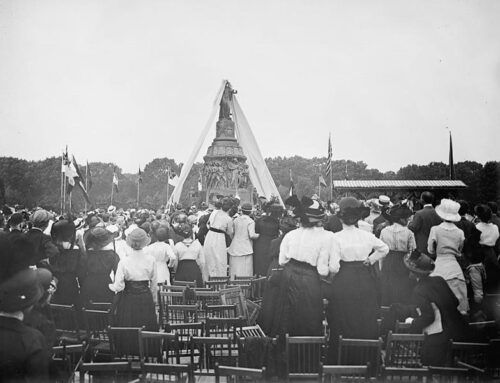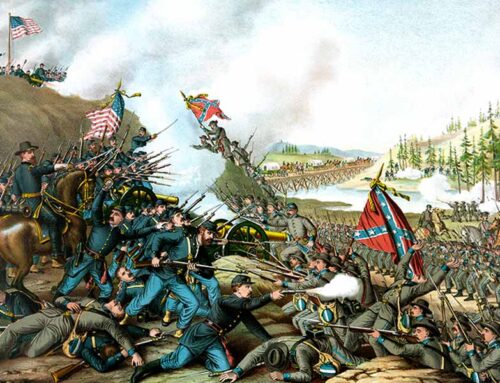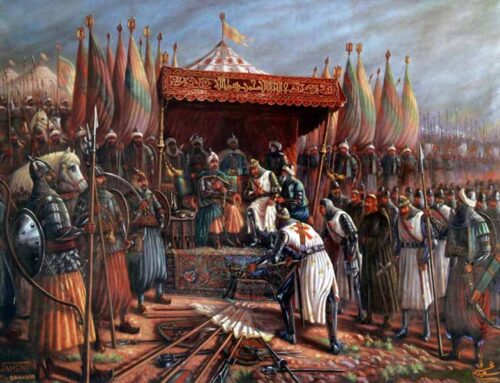“When the righteous are in authority, the people rejoice: but when the wicked beareth rule, the people mourn.” —Proverbs 29:2
Execution of Charles I, January 30, 1649
![]() pon the death of Queen Elizabeth I, the Tudor line of the English monarchy came to an end, and the Stuart family of Scotland inherited the English throne; James VI, Elizabeth’s first cousin, twice removed, became James I. The Stuart Kings of England emerged as a troubled and controversial series of stubborn autocrats whose word became law and their position as “head of the church” resulted in ecclesiastical tyranny known as Erastianism. James had been tutored by one of the most brilliant and theologically Reformed men of his day, George Buchanan, but his stubborn student was easily swayed when he ascended the throne of England. Persecuting the English Puritans and the Scottish Presbyterians, incrementally, James was able to maintain a shaky peace. Charles picked up where his father left off, but even more uncompromising and antagonistic than the senior Stewart. Charles I’s character and perseverance in promoting his own insistent tyranny over the Church and Parliament cost him his throne and head, “for committing treason and subverting justice.”
pon the death of Queen Elizabeth I, the Tudor line of the English monarchy came to an end, and the Stuart family of Scotland inherited the English throne; James VI, Elizabeth’s first cousin, twice removed, became James I. The Stuart Kings of England emerged as a troubled and controversial series of stubborn autocrats whose word became law and their position as “head of the church” resulted in ecclesiastical tyranny known as Erastianism. James had been tutored by one of the most brilliant and theologically Reformed men of his day, George Buchanan, but his stubborn student was easily swayed when he ascended the throne of England. Persecuting the English Puritans and the Scottish Presbyterians, incrementally, James was able to maintain a shaky peace. Charles picked up where his father left off, but even more uncompromising and antagonistic than the senior Stewart. Charles I’s character and perseverance in promoting his own insistent tyranny over the Church and Parliament cost him his throne and head, “for committing treason and subverting justice.”

James VI and I (1566-1625)

Charles I (1600-1649) as Prince of Wales
Born in 1600, Charles had been a sickly child and spoke with a stammer his entire life. A presbyterian Scot, Thomas Murray was appointed his tutor throughout his younger years. Charles overcame his childhood physical weakness to become an accomplished rider, marksman, and fencer, destined as the Duke of York to play second fiddle to his older brother Henry, the Prince of Wales. Providence, as is so often the case, stepped into Charles’s future with the death of Henry at the age of eighteen. Thus, Charles became the heir apparent at age twelve.

Henry Frederick, Prince of Wales (1594-1612)
King James died in 1625, leaving a rebellious and recalcitrant Parliament for the twenty-five-year-old Charles I to contend with, along with various ecclesiastical and foreign policy controversies to settle. Charles swiftly married the fifteen-year-old Princess Henrietta Maria of France, secretly promising to his brother-in-law Louis XIII to lift restrictions against Catholics in England. Charles told Parliament that he would maintain the restrictions on the Catholics of England, thus demonstrating (to history at least) the duplicitous nature of his character, a pattern he would follow all the way to his death. He was crowned on February 26, 1626 without his wife by his side because she would have nothing to do with a Protestant ceremony.

Charles I and his wife, Henrietta Maria (1609-1669)
Charles embraced Arminian theology, thus rejecting the Calvinism inherited through his own education, and he chose as Archbishop of Canterbury William Laud, who codified Charles’s innovations in the Church liturgy, seeming like a return to Roman Catholic practices. When Parliament resisted both the religious changes and also refused the King’s request for increased tax revenues, the monarch suspended Parliament and ruled England by royal fiat for the next eleven years. Puritans who resisted increased power of the King’s bishops and regarded his innovations in worship as heresy faced torture and persecution. In the decade of the 1630s, more than 20,000 English Puritans sailed for New England to establish a biblical commonwealth in the New World, without bishops.

William Laud, Archbishop of Canterbury (1573-1645)

Jenny Geddes famously pitching her stool at James Hannay, Dean of Edinburgh, as he reads from the politically and religiously controversial Book of Common Prayer, which event kicked off riots against the English Catholicizing of staunchly Protestant Scotland, and from there further uprisings, quickly rising to the Bishops’ Wars of 1639 and 1640
Charles I tried to stop the Second Reformation in Scotland. The Holy Spirit won that encounter as He does them all, with the widespread revival that swept Scotland in the 1640s. Our Lowlands tour focuses on that spiritual awakening, and the subsequent persecution that lasted from 1660-1688. How ironic that the trumpet of the Reformation in Scotland, John Knox, is buried within a few feet of the monument to Charles, behind St. Giles Kirk, where the Gospel rang out for three hundred years. Learn More >
In 1640 Charles gathered a royal army to attack Scotland and force the “covenanted Presbyterians” to conform to the new liturgies in the Church. When met with overwhelming force, Charles negotiated a quick peace and called Parliament back into session to request money to raise a larger army to defeat the Scots. Rebuffed by the new Puritan-dominated Parliament, Charles tried for two years to extend his powers over Parliament and to make war on Scotland for rejecting his ecclesiastical authority. Failing on all fronts, Charles I raised his standards at Nottingham and established his court at Oxford. He, in essence, declared war on the England and Scotland who would not conform to his high-handed “divine right of kings.” The English Civil Wars lasted from 1642 to 1648.

“The Divine Right of Kings” is pictured here as Charles I is portrayed being crowned by a hand reaching out of heaven

Charles I (center, in blue sash) before the Battle of Edge Hill, 1642, during the English Civil Wars; the young Prince of Wales (later Charles II) and Duke of York (later James II) can be seen on the left as both were present for the battle and even had to be ushered away to safety as the Royalist lines faltered
Through the first three years of the war, neither side could gain a decisive advantage. The Parliamentary and Scots Army won a number of significant engagements, as did the Royal forces. After the Battle of Naseby in 1645, however, the Royal forces suffered a succession of defeats as the Parliamentary army—redesigned and in the field as “The New Model Army”, led by Lord Fairfax and his best general, Oliver Cromwell—finally surrounded Oxford. The King escaped the encirclement and surrendered to the Scots, expecting good treatment and a negotiated peace with them. In 1647 the Scots were persuaded to turn over the King to Parliament.

The victory of the Parliamentarian New Model Army at the Battle of Naseby (June 14, 1645) marked the decisive turning point in the English Civil War
At first Parliament tried to negotiate with the King, offering a constitutional arrangement sharing powers. Charles rejected any compromise regarding his absolute authority, and he secretly accepted the Scottish covenant in return for recognition and assistance, known as “the Engagement,” thus provoking the Second Civil War against Parliament. General Cromwell—the most influential member of Parliament and the Army—considered Charles’s secret negotiations with the Scots, Irish and French the height of treason against England. The majority “presbyterian party” of the parliament sought further treating with the King, but Cromwell and the Army intervened after defeating the Royal forces again, and purged the legislature of all representatives not in agreement with the Army.

Death warrant of Charles I, signed and sealed by 59 of the 67 commissioners
The new “Rump Parliament” established a high court tribunal to try the King for high treason. He was held accountable for the deaths of more than 185,000 people who had perished in the wars, and for making war against his own nation. The trial began on January 19, 1649 when the Solicitor General John Cooke read the indictment. Charles refused to enter a plea, declaring the court invalid and the trial an illegal mockery of justice. His authority came from God and he was the legal crowned and anointed King; he claimed sovereign immunity from prosecution. Fifty-nine of the sixty-seven commissioners signed his death warrant, which declared that Charles would be beheaded as a tyrant, murderer, and public enemy to the people of England. His execution was carried out on January 30, 1689.

The public execution of Charles I for his many crimes against his subjects
A third Civil War broke out, with fighting in Ireland, England, and Scotland, with the utter defeat of all the armies loyal to the King by Oliver Cromwell and the New Model Army. Cromwell rejected the offer of the crown and instead established the English Commonwealth, with himself as “The Lord Protector”, which lasted about ten years. This ended with the return to England from France of exiled King Charles II: a tyrant, consummate liar, murderer, and voluptuary that put his father’s crimes in the shade—a story for another day.

Cromwell viewing the body of Charles I

For further study, read The Tyrannicide Brief, by Geoffrey Robertson
Image Credits: 1 James I (wikipedia.org) 2 Charles I (wikipedia.org) 3 Prince Henry (wikipedia.org) 4 Charles & Henrietta (wikipedia.org) 5 William Laud (wikipedia.org) 6 Jenny Geddes (wikipedia.org) 7 Divine Right of Kings (wikipedia.org) 8 Eve of the Battle of Edge Hill (wikipedia.org) 9 Battle of Naseby (wikipedia.org) 10 Charles I’s death warrant (wikipedia.org) 11 Execution of Charles I (wikipedia.org) 12 Cromwell viewing Charles I’s body (wikipedia.org)







